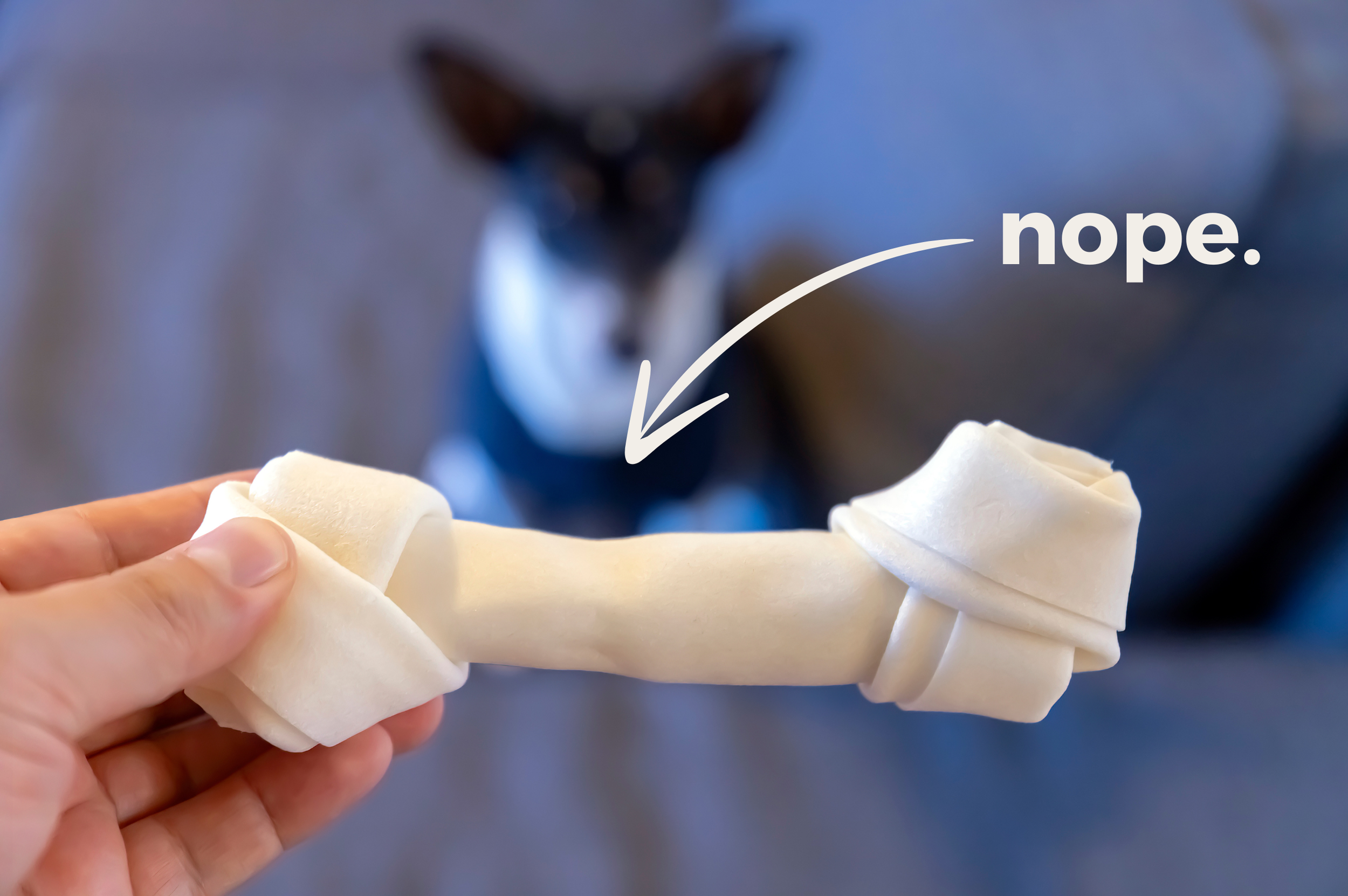The Dangers of Rawhide
Just going to skip right to the point here: rawhides are dangerous and you should never give them to your dog.
Digestive Blockages
Even if your dog manages to swallow large pieces of rawhide without choking, these pieces can still pose a significant risk once they reach the digestive system. Rawhide is not easily digestible, and large chunks can cause blockages in the esophagus, stomach, or intestines. Such blockages can lead to severe gastrointestinal issues, including vomiting, diarrhea, and lethargy. In some cases, surgery may be required to remove the obstruction.
Contamination and Allergies
Rawhide bones are often treated with various chemicals during the manufacturing process. These chemicals can include bleach and hydrogen peroxide, used to clean and preserve the rawhide. Unfortunately, these substances can cause allergic reactions in some dogs, leading to symptoms such as itching, swelling, and gastrointestinal upset.
Additionally, rawhide bones can be contaminated with harmful bacteria such as Salmonella or E. coli. These bacteria can not only make your dog sick but also pose a risk to human health, especially if you have young children, elderly individuals, or immunocompromised family members in your home.
Long-Term Health Risks
Chewing on rawhide can also lead to dental problems over time. While some believe that chewing helps clean a dog's teeth, rawhide can actually cause excessive wear and tear on the teeth, leading to dental fractures and other issues. Moreover, the repetitive, intense chewing required to break down rawhide can strain a dog's jaw muscles and joints, potentially leading to chronic pain and discomfort.
How Rawhides Are Made
Understanding the production process of rawhide bones can provide further insight into their potential dangers. Rawhide is a byproduct of the leather industry, typically made from the inner layer of cow or horse hides. The production process generally involves the following steps:
Collection and Cleaning: The hides are collected and thoroughly cleaned to remove any residual hair, fat, and tissue.
Chemical Treatment: The cleaned hides are then treated with various chemicals, such as bleach and hydrogen peroxide, to whiten and preserve the rawhide. This chemical treatment helps to prevent spoilage and extend the shelf life of the product.
Shaping and Drying: The treated rawhide is cut, shaped into bones or other chewable forms, and then dried. This drying process can take several days and is often done in large industrial ovens.
Final Processing: Finally, the dried rawhide chews may be coated with flavorings or additional preservatives before being packaged and shipped for sale.
Safer Alternatives
Given the risks associated with rawhide bones, it's wise to consider safer alternatives for your dog's chewing needs. Here are a few options:
Rubber Chew Toys: Durable and designed to withstand heavy chewing, rubber toys can provide a safe and long-lasting alternative to rawhide. Below are some of Deuce’s & his friends’ favorites.
Natural Chews: Options like bully sticks, antlers, and dental chews made from natural ingredients can satisfy your dog's urge to chew without the risks associated with rawhide. Below are some of Deuce’s & his friends’ favorites.
Edible Chews: Look for treats specifically designed to be both chewable and digestible, such as dental sticks or flavored bones made from safe, natural ingredients. Below are some of Deuce’s & his friends’ favorites.
The Bottom Line
While rawhide bones may seem like a convenient and enjoyable treat for your dog, the potential dangers they pose make them a risky choice. From choking hazards and digestive blockages to chemical contamination and dental issues, the risks far outweigh the benefits. By opting for safer alternatives, you can ensure that your dog remains happy, healthy, and safe during their chewing sessions. Always consult with your veterinarian before introducing new chews or treats to your dog's routine, and stay informed about the best practices for maintaining your pet's health and well-being.
The Good Boy Foundation is committed to providing valuable resources and education to empower pet parents in caring for their furry companions. However, it's important to note that the information provided on our website is intended for educational purposes only and should never replace the advice or treatment provided by a licensed veterinarian. While we strive to offer accurate and helpful guidance, we cannot be held responsible for any outcomes or consequences resulting from the application of this information. Pet parents are encouraged to consult with their veterinarian for personalized guidance and recommendations tailored to their pet's specific needs and circumstances.


